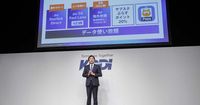KDDI, a major player in Japan's telecommunications sector, announced on May 7, 2025, a series of significant changes to its pricing structure, including the launch of new plans and price increases for existing services.
Starting June 2025, KDDI will introduce its "au Value Link Plan," which enhances the benefits associated with the fifth generation (5G) mobile communication system. This new plan will be priced at 8008 yen per month (including tax) and aims to bolster overseas data usage as well as provide a return on common points known as "Ponta." In comparison, the existing high-capacity plan, "Unlimited Use MAX+," will see an increase from 7458 yen to 7788 yen, marking a price hike of 550 yen.
In addition to the new plan, KDDI will also raise prices for most of its existing plans, with increases ranging from 110 to 330 yen, effective August 1, 2025. Notably, the "Unlimited Use MAX+" plan will automatically adjust to the new price without requiring any action from customers.
Hiroji Matsuda, KDDI's president, explained that the adjustments are necessary due to rising costs associated with labor and materials for equipment construction and maintenance. He stated, "We will continue to create and provide value to earn compensation," indicating a commitment to maintaining service quality even as prices rise. Matsuda emphasized that the company is not merely implementing a price increase but is also focused on providing added value to customers.
These changes come in the wake of similar announcements by other major telecommunications companies in Japan. NTT Docomo, for instance, has already declared a substantial price increase for its primary plans, set to take effect in June 2025. Its new "docomo MAX" plan will cost 8448 yen per month, representing an increase of over 1000 yen from existing plans. This plan will include additional features such as the video distribution service DAZN, which will be bundled with the plan, making it mandatory for users.
The ongoing price hikes have sparked discussions about the competitive landscape among Japan's three main telecom providers—NTT Docomo, KDDI, and SoftBank. As these companies raise their prices, they are closely monitoring each other's moves. SoftBank's president, Kenichi Miyakawa, has also indicated a willingness to increase prices, suggesting a shift in the industry away from the aggressive price-cutting strategies that have characterized recent years.
As KDDI and NTT Docomo implement their new pricing strategies, the impact on consumers remains to be seen. Many customers may feel the pinch of higher mobile bills, especially as the cost of living continues to rise in Japan. The telecom giants, while citing increased operational costs, must balance their need for profitability with customer satisfaction to avoid backlash.
In addition to the direct price increases, KDDI's new offerings aim to enhance customer experience during peak usage times. The company is introducing features that allow for comfortable 5G communication even in congested areas, as well as unlimited overseas data communication for up to 15 days per month without additional charges. Furthermore, KDDI is incorporating the "au Starlink Direct" service, which enables direct communication between satellites and smartphones, into its plans. This service was initially launched for free in April 2025 but will now be part of the paid plans.
Both KDDI and NTT Docomo's pricing adjustments reflect broader economic trends impacting telecommunications in Japan. Rising electricity costs, driven by fluctuations in fuel prices and exchange rates, have significantly affected operational expenses. Major telecom companies have seen their electricity bills soar in recent years, which has prompted them to reassess their pricing strategies.
Moreover, construction and labor costs have also been on the rise. Matsuda highlighted the challenges posed by increasing expenses for partner companies, including construction firms and sales agencies. The labor shortages and escalating material prices have led to higher costs for the construction and maintenance of telecommunications infrastructure, further complicating the financial landscape for these companies.
As KDDI and its competitors navigate these challenges, their ability to create a "virtuous cycle"—whereby they provide value to customers, receive fair compensation, and reinvest in their services—will be crucial for long-term sustainability. Matsuda's remarks about the importance of continuing to deliver valuable services resonate with the need for telecom providers to innovate and enhance their offerings amidst rising costs.
With the telecommunications market in Japan at a pivotal moment, the decisions made by KDDI, NTT Docomo, and SoftBank will likely shape the industry's direction for years to come. As consumers brace for the effects of these price increases, the companies must remain vigilant in addressing customer concerns while adapting to the economic realities of their operating environments.
In summary, KDDI's recent announcements mark a significant shift in Japan's telecom landscape, as major providers adjust their pricing strategies in response to rising operational costs. The introduction of new plans and features aims to enhance customer experience, but the potential for consumer backlash looms as prices rise amid a competitive market.




